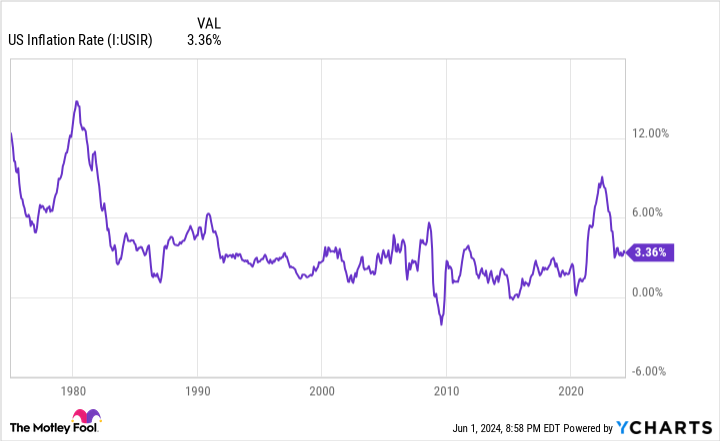In April, close to 51 million retired-worker beneficiaries brought home an average Social Security check of $1,915.26. Although this isn’t a game-changing amount of monthly cash, Social Security benefits have proved vital to the financial well-being of most retirees.
In addition to pulling approximately 16.5 million seniors aged 65 and over out of poverty in 2022, Social Security benefits represented a “major” or “minor” source of income for 88% of the retirees surveyed by national pollster Gallup this past April. Considering how important Social Security income is to the financial foundation of retirees, all eyes have begun turning to the 2025 cost-of-living adjustment (COLA).

Why is Social Security’s cost-of-living adjustment so important?
Put simply, Social Security’s COLA is the tool used by the Social Security Administration (SSA) to account for changes in the price of goods and services. For example, if the price for a broad basket of goods and services that seniors regularly buy increases from one year to the next, Social Security benefits should, in a perfect world, rise by a commensurate amount to ensure no loss of purchasing power. Keeping benefits on par with inflation is what Social Security’s COLA is all about.
Before 1975, cost-of-living adjustments were entirely arbitrary and passed along by special sessions of Congress. Only 11 benefit increases were passed between 1940 and 1975, with none administered during the entire 1940s.
Things changed in 1975. For roughly the last half-century, the Consumer Price Index for Urban Wage Earners and Clerical Workers (CPI-W) has served as the program’s annual measure of inflation. The CPI-W has more than a half-dozen major spending categories and a plethora of subcategories, all of which have their own respective weightings. These weightings are what allow the CPI-W to be reported as a single figure each month, which makes for easy comparisons to previous months or the prior year to determine if inflation (rising prices) or deflation (falling prices) has occurred.
Social Security’s COLA calculation is unique in that only the CPI-W readings from the third quarter (July through September) factor into the calculation. While the end readings from the other nine months can help identity price trends, they won’t be used by the SSA to calculate Social Security’s COLA for the upcoming year.
In simple terms, if the average CPI-W reading from the third quarter of the current year is higher than the average CPI-W reading during the comparable period of the previous year, inflation has occurred and beneficiaries are due a bigger payout. The year-over-year percentage change in average third-quarter CPI-W readings, rounded to the nearest tenth of a percent, determines how much Social Security checks will increase in the upcoming year.
Here’s how much Social Security checks are forecast to rise in 2025
Over the last three years, Social Security beneficiaries have enjoyed a meaningful boost to their monthly checks, with cost-of-living adjustments of 5.9% (2022), 8.7% (2023), and 3.2% (2024). For context, the average COLA over the last 20 years was 2.6%. Beneficiaries are hopeful that an above-average hike awaits in 2025.
On May 15, the U.S. Bureau of Labor Statistics released its much-anticipated April inflation report, which offered clues as to which direction collective prices are headed. The CPI-W increased by 3.4% over the last 12 months, which remains well above the Federal Reserve’s long-term target of a 2% prevailing rate of inflation.
Thanks to stubbornly high core inflation, which removes food and energy costs from the equation, nonpartisan senior advocacy group The Senior Citizens League (TSCL) has, once again, increased its long-term forecast for Social Security’s 2025 COLA. Although we still haven’t reached the months that actually matter in the COLA calculation, TSCL believes the 2025 COLA will come in at 2.66%, which would round up to 2.7%. If accurate, this would (barely) mark a fourth consecutive year of above-average COLAs for beneficiaries.
But it’s one thing to see a percentage forecast on paper and an entirely different beast to see how that percentage can tangibly impact Social Security checks. With the understanding that COLA forecasts are still fluid, let’s take a closer look at exactly how much a 2.7% cost-of-living adjustment would increase Social Security checks in 2025.
For retired workers, who I noted earlier brought home an average check of $1,915.26 in April, a 2.7% COLA would translate into a $52 monthly increase next year. In short, the average retired-worker beneficiary would be bringing home about $1,967 each month, if this prognostication proves accurate.
Workers with disabilities and survivor beneficiaries would see meaningful boosts to their monthly payouts, too. The roughly 7.25 million workers with disabilities who received benefit checks in April would see their monthly payouts rise by an average of $42 to $1,579. Meanwhile, the 5.8 million survivor beneficiaries can expect their monthly checks to increase by $41, to an average of $1,544.

Keep the champagne on ice
Although most signs point to Social Security recipients enjoying a fourth straight year of above-average cost-of-living adjustments, the 2025 COLA is unlikely to be cause for celebration. While a higher inflation rate appears set to increase benefits, the costs that matter most to seniors are rising at an even faster clip.
For example, seniors devote a higher percentage of their monthly expenditures to shelter expenses and medical-care services than the typical working-age American. Higher mortgage rates have brought the housing market to a virtual standstill and caused shelter inflation to remain stubbornly high (5.5% over the last 12 months, based on the Consumer Price Index for All Urban Consumers, or CPI-U). A slightly above-average COLA isn’t going to make a dent if shelter inflation remains well above historic norms.
Likewise, medical-care services inflation has picked back up over the last six months and currently sits at an increase of 2.7% over the trailing-12-month period.
The pace at which shelter and medical-care services are increasing suggests that seniors, who make up roughly 86% of Social Security’s beneficiaries, are going to see the pricing power of their Social Security dollars decline in 2025. According to a TSCL study from May 2023, the purchasing power of a Social Security dollar plunged by 36% between January 2000 and February 2023.
Unfortunately, there’s no easy fix for this ongoing loss of purchasing power for a majority of the program’s beneficiaries. The CPI-W is inherently flawed and focused on the spending habits of working-age Americans who, in many instances, aren’t receiving a Social Security check and spend their money very differently than seniors. Without change on Capitol Hill, Social Security beneficiaries appear destined for disappointment with the 2025 COLA on deck.
What stocks should you add to your retirement portfolio?
The Motley Fool Stock Advisor analyst team just identified what they believe are the 10 best stocks for investors to buy now. The 10 stocks that made the cut could produce monster returns in the coming years, potentially setting you up for a more prosperous retirement.
Consider when Nvidia made this list on April 15, 2005… if you invested $1,000 at the time of our recommendation, you’d have $741,362!*
Stock Advisor provides investors with an easy-to-follow blueprint for success, including guidance on building a portfolio, regular updates from analysts, and two new stock picks each month. The Stock Advisor service has more than quadrupled the return of S&P 500 since 2002*.
The Motley Fool has a disclosure policy.
Here’s Exactly How Much Social Security Checks Are Forecast to Rise in 2025 was originally published by The Motley Fool

